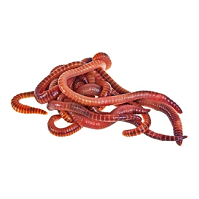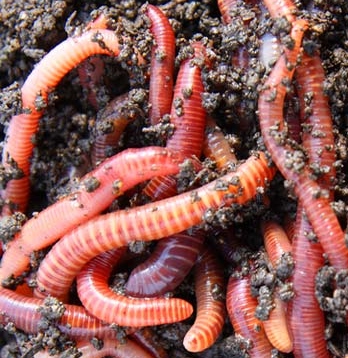Red wigglers: For indoor setups
Red wigglers: For indoor setups
Blog Article
Red Wigglers: Your Eco-Friendly Option for a Greener Yard
Red wigglers, or Eisenia fetida, offer a lasting method to enhancing yard wellness with vermicomposting. By incorporating red wigglers right into your horticulture methods, you can successfully take care of waste while nurturing a vibrant environment.
(red worms for sale)
What Are Red Wigglers?
Although frequently mistaken for normal earthworms, red wigglers (Eisenia fetida) are a distinct varieties known for their effectiveness in composting raw material. These worms thrive in abundant, organic environments, such as compost heap and vermicomposting systems, where they play a crucial role in damaging down waste. Unlike their more common equivalents, red wigglers like a warmer habitat, usually in between 55 ° F and 77 ° F, which maximizes their activity and efficiency.
Red wigglers are characterized by their reddish-brown pigmentation and fractional bodies, which can grow up to four inches in size. They possess a special capacity to consume and absorb organic materials at an excellent rate, refining up to half their body weight daily. This fast disintegration process not just improves the dirt but likewise contributes to the general wellness of the garden environment.
In terms of reproduction, red wigglers are prolific, with the ability of generating cocoons that include multiple eggs. This permits for quick populace growth, making them an excellent choice for composting ventures. Their adaptability and ravenous appetite for organic waste setting red wigglers as an essential ally for environmentally mindful garden enthusiasts looking for sustainable practices.
Benefits of Using Red Wigglers
Utilizing red wigglers in the garden supplies various advantages that boost both soil top quality and plant health. These earthworms are remarkable decomposers, breaking down raw material such as kitchen area scraps and lawn waste into nutrient-rich spreadings. These spreadings, usually described as "worm gold," supply important nutrients that boost dirt fertility, promoting lively plant development.
Red wigglers additionally improve soil framework. The existence of red wigglers boosts microbial activity in the dirt, creating a flourishing ecological community that adds to condition resistance and boosted plant health and wellness.
Another significant advantage of utilizing red wigglers is their ability to decrease waste. In recap, integrating red wigglers into horticulture practices yields substantial advantages, making them a useful enhancement to any eco-conscious garden.
(Hickory)
How to Begin Vermicomposting
To start vermicomposting, it's important to create an appropriate environment for red wigglers to flourish, as their success straight impacts the effectiveness of the composting procedure. Beginning by selecting a container, such as a plastic or wooden container, with appropriate water drainage and air flow. A dimension of around 2 square feet is excellent for a family, allowing for a manageable worm populace.
Next, prepare bed linens material that is wet however not extremely damp. Shredded newspaper, cardboard, and coconut coir are outstanding selections, giving a comfortable habitat while also acting as a carbon resource. Fill the bin with 4 to 6 inches of bedding.
After establishing the bed linens, present your red wigglers. A regular beginning population is about 1 pound of worms, which can take in approximately half a pound of food scraps daily. It is vital to add food scraps progressively, focusing on vegetable peelings, fruit waste, and coffee grounds, while staying clear of meat, dairy, and oily foods to stop smells.
Preserving a Healthy And Balanced Worm Bin
When your red wigglers are resolved right into their brand-new bed linen, maintaining a healthy worm container becomes extremely important to make sure optimal composting conditions. The key elements to check consist of wetness, temperature level, and aeration. Preferably, the worm bin must be maintained damp but not soggy; a humidity level around 60-70% is ideal. To achieve this, frequently check the bed linens and add water as needed, while also making use of completely dry materials such as shredded paper to soak up excess dampness.
Temperature level control is equally important. Red wigglers grow in settings in between 55 ° F and 77 ° F(13 ° C to 25 ° C) Avoid exposing the container to extreme temperatures; severe warmth can kill the worms, while too much cold can slow their activity.
Aeration is critical to avoid anaerobic problems, which can cause unpleasant odors and harm the worms. Turn the bed linen gently every couple of weeks to promote air movement and distribute food see this website evenly.
Feeding your red wigglers is an additional essential element. Offer a well balanced diet plan of cooking area scraps, staying clear of citrus and spicy foods, which can be damaging to their wellness. By consistently checking these aspects, you can make sure a successful community within your worm bin.

Tips for Utilizing Worm Castings
Consistently integrating worm spreadings right into your garden can considerably improve dirt health and wellness and plant growth. To effectively make use of worm spreadings, start by identifying the suitable application rate, which typically varies from 10-20% of the complete dirt quantity. This guarantees optimal nutrient schedule without overwhelming your plants.
When using worm spreadings, mix them into the top couple of inches of soil around well-known plants or include them right into your seed-starting mix for new seedlings. Furthermore, consider developing a worm tea by soaking worm castings in water for 24-48 hours.

Final Thought
The application of red wigglers in horticulture practices provides a lasting strategy to waste administration and soil enrichment. The assimilation of red wigglers into gardening routines eventually sustains both eco-friendly balance and agricultural productivity. red worms.
Report this page